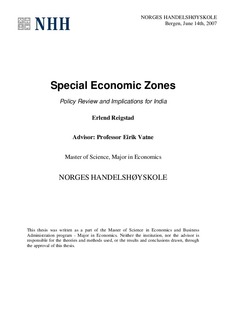| dc.description.abstract | The thesis deals with special economic zones (SEZs). The first part, chapter 2-5, explains them as a phenomenon. Their history and features/incentives are spelled out, as are their underlying rationale – the advantages the host can achieve through them (chapter 4.1). These possible advantages include increased employment; cluster effects; technology transfer and training; partial policy reforms; laboratory simulations of economic policy and being a means of regional policies. An important way SEZs can achieve this is to attract foreign direct investments. Also the possible costs of zones are presented (chapter 4.2) as well as their alternative cost (chapter 4.3). To complete this part of the analysis chapter 5 presents the point of view of the firms, i.e. the investors SEZs are supposed to lure.
The second part of the thesis, chapter 6-7, applies the first part on the case of India. This results in some specific advice, implications, for the SEZ policy of India. These include using SEZs as laboratories to find beneficial general economic policies and SEZ policies; to include the Indian diaspora to a greater extent to achieve the chapter 4.1 advantages; the promotion of cluster effects; as well as others. The rapid change in the Indian economy increases the uncertainty, but the main recommendations should be robust in all likely scenarios. | en |
